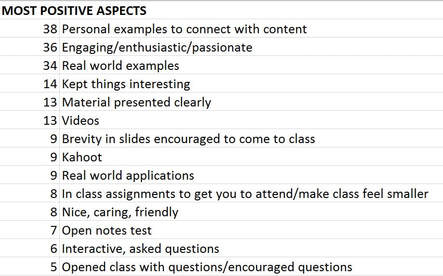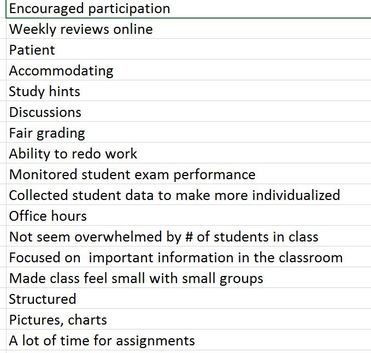And now, student evaluations of teaching. I will refer to them as SETs which is what they are called at UConn.
The first time I received student evaluations of my teaching I was a graduate student TA for a section of research methods. I called a friend and told her I was sad because I had a really negative review. She said, really, I had great reviews! And after we talked for a while, we figured out that both of us had mostly positive feedback with 1-2 negative people in the pile, it was just that I perseverated on the negative one and couldn’t remember the positive ones, and she ignored the negative and focused on the positive.
I still find it hard not to perseverate on negative feedback in my SETs. I think it’s because the most negative ones are generally the most strongly emotionally valenced, and so they are the most memorable. At least to me. I really want to take student evaluations into account when I revise my course each year. But I find that if I’m not careful, those highly emotionally valenced ones may sway my view. I have even at times changed a course in response to such a review, having then the next year more students complain about the new format.
SETs don’t have the same meaning for me now that I am post-tenure, post-full professor. Previously it at times felt like SETs were linked to job security. Now, to be honest, as long as I don’t get scores low enough to raise eyebrows in the Provost’s Office, no one is going to care much about my SETs.
All that said, I do want to learn what students did and didn’t like about my courses, and figure out how to improve them. I had a colleague who prided himself on never looking at his teaching evaluations. I’ve had other colleagues who, when I was Undergrad Director and met with them to discuss lower ratings, would blame it all on the students, such as, “this was such a bad bunch this semester.” I can’t quite understand that. I don’t think we should bend over backwards to please students all the time, but I do think we need to consider students’ perspective on the course.
When I was Undergrad Program Director, I often had to help other faculty interpret their SETSs and figure out how to respond to them in course design. During this process, I developed a way to summarize the SETs for others, and I now use that technique with my own SETs. If you teach a small graduate course, you may find this technique less useful. But if you have a large course like mine, then summarizing them may help you find patterns.
Essentially what I am doing is coding the responses. I pull up the open-ended responses, open an Excel file, and read through them one at a time. For each one, I try to code or categorize any unique point that person says. I keep a running tally of each point, so that the second time someone says “she was so enthusiastic!” I don’t make a new line, I just add a count to the line “enthusiastic/energetic/engaging.” I do separate summaries for “Most positive aspects” and “What can instructor do to change.” Once I’m done coding, I sort them by # of responses in descending order, and I can much more easily see the patterns and get a sense of the overall student perspective, rather than only remembering the most strongly worded ones.
This year, when I first received my SETs for my 290 student class at the end of the semester, I skimmed them but didn’t take the time to read them. The sense I came away with from them was that they overall liked me and thought I was enthusiastic, but that students also were unhappy that I made them do group assignments because the class was a mix of freshmen – seniors; unhappy that instructor seemed unsure of herself; and unhappy that I relied on my notes too much. But when I tabulated, those last three points were literally each from one person – in a class of 290. That’s what I remembered the most, though. So instead, when I tabulated them, I could much more easily see the trends. Here are all of the answers to the question about “most positive aspects” that 5 or more students made:
Toward the bottom I can see the things that only one student mentioned as a positive:
Some students thought my (open-notes, open-book) exams were tricky. And some students thought I should be more clear about what exams would be like and what would be on exams. So I can probably spend more time in class pointing out some of the concepts that students find tricky, and talking about how to use the weekly review questions I post. A lot of the things I got out of this section of my SET’s are about ways I can help the students understand what is happening in the course, rather than changing my policies per se. But there definitely have been times that I have read something in my SET’s that has made me make some more radical changes in my course.
This technique has really helped me take the emotion out of reading my SETs, so that I can concentrate on what students do and don’t appreciate about the course, and respond appropriately. How do you deal with student evaluations of teaching?
“How to gather useful information from student evaluations of teaching first appeared on Eva Lefkowitz’s blog on October 18, 2018.”




 RSS Feed
RSS Feed
